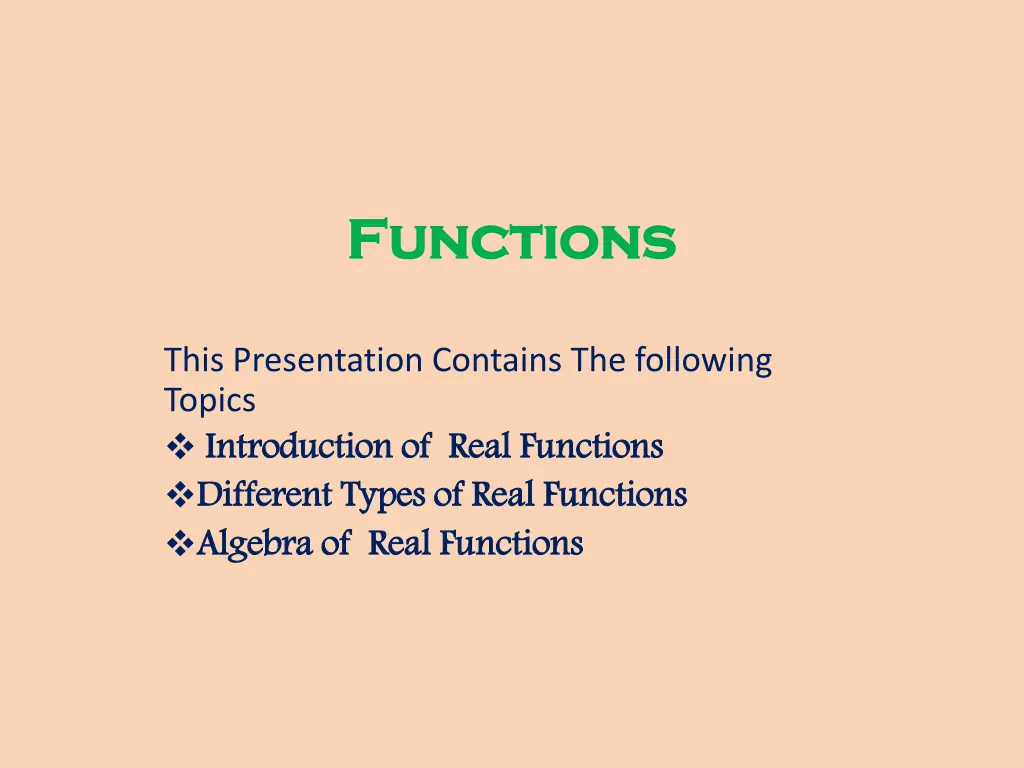
Understanding Real Functions: Types, Algebra, and Examples
Explore the concepts of real functions, including definitions, domain, range, and key features through examples. Learn about different types of functions, algebraic operations, and how to determine if a relation is a function.
Download Presentation

Please find below an Image/Link to download the presentation.
The content on the website is provided AS IS for your information and personal use only. It may not be sold, licensed, or shared on other websites without obtaining consent from the author. If you encounter any issues during the download, it is possible that the publisher has removed the file from their server.
You are allowed to download the files provided on this website for personal or commercial use, subject to the condition that they are used lawfully. All files are the property of their respective owners.
The content on the website is provided AS IS for your information and personal use only. It may not be sold, licensed, or shared on other websites without obtaining consent from the author.
E N D
Presentation Transcript
Functions Functions This Presentation Contains The following Topics Introduction of Real Functions Different Types of Real Functions Algebra of Real Functions Introduction of Real Functions Different Types of Real Functions Algebra of Real Functions
Function is a special case of relation. It can be defined as follows: Definition : If A and B are any two non- empty sets then a subset Of A x B is called a function from A to B iff for each a A, there exits a unique or only one b B such that (a,b) f. it is written as f : A ----> B. So we can say that a subset f of A x B is said to be a function from A to B iff: i. For each a A there exits b B such that (a , b) f and ii. No two different ordered pair have same first element. Image of an element :- The unique element b B is called the image of the element a of A under the rule or function f : A ----> B. It is denoted by f(x) i.e y = f(x) . The element y is also called the value of the function of x.
Domain and Range of a Function : Let f be a function from A to B, then the set A is called the domain of the function f and the set B is called the codoamin. The set consisting of all the images of the elements of A under the function f is called the range of f. Example 1: Let A = { 1,2,3,4,5} and B = { 0,1,2,3,5,7,9,11} and we have (i) f = {(1,1), 2,0), (3,7), (4,9), (5,13)} is a function because every element of A has a unique image in B. (ii) f = {( 1,5), (2,7), (2, 9), (4,7), (5,11)} is not a function , because two different ordered pair have same first element. (iii) f = {(1, 0), (2,5), ( 4,9), ( 5,13)} is not a function, because the element 3 of A has no image in B. Example 2 : Let X = { a,b,c,d} and Y = { p, q,r, s, t}. Then the function f : X----> Y can be defined by arrow diagram as follows.
The arrow diagram is p q r s t a b c d from the above arrow diagram we can say that Domain of f = { a,b,c,d} and Range of f = { q,r,s,t} and in terms of ordered pair the function can be written as f = {(a, q), (b, r), (c, s), (d, t)} This representation of function is called the function by mapping .
Main features of a function Let f be a function from X to Y, then to every x X, there exits a unique element y Y such that y = f(x). no element of X can have more then one image in Y. there may be elements of Y which are not the images of any element of X. distinct elements of X may have same image in Y. Example 3: which of the following relations are functions ? Give reasons. (i) R = {(2,1), (3,1), (4,2)} (ii) R= {(2,3), (3, 5),(2,7), (-4,6)} Sol. (i) Domain of f = { 2,3,4}. We note that each element of the domain has a unique image, therefore R is a function. (ii) Domain of f = { 2, 3, -4}.We note that the element 2 has two different images 3 and 7, therefore R is not a function.
Real Function : A function which has either R or one of its subsets as its range is called a real valued function. Further if its domain is also either R or a subset of R, it is called a real function. i.e f : R ----> R , is a real function . Some Functions and Their Graphs : (i) Identity Function : The function f defined by y = f(x) = x for all x R, is called the Identity function . The graph of this function is a straight line passing through the origin Y X X Y
(ii) Constant Function : - The function f : R -----> R defined by y = f(x) = c , for all x R , where c is a constant , is called the constant function. The domain of this function is R and its range is { c } . Y X X Y (iii) Polynomial Function :- A function f : R ----> R is said to be polynomial function, if for each x in R the function is defined as y = f(x) = a0 + a1 x + a2 x2+ . + an xn , where n is non negative integer and a0 , a1, . an R.
Example : a function f : R -----> R , defined as f(x) = x3 2x2 +3 , is a polynomial function . The graph of a polynomial function is a curve. Y Y X X X X Y Y (iv) Modulus Function :- The function f : R -----> R defined by f(x) = |x| , for all x R is called modulus function. It can be defined as follows : f(x ) = x , x 0 -x , x < 0 The graph is shown above.
(v) Signum Function :- The function f : R -----> R defined by 1, if x > 0 f(x) = 0, if x = 0 -1, if x < 0 is called the signum function. The domain of this function is R and the range is the set { -1, 0, 1} . The graph is shown bellow. Y Y X X X X Y Y (vi) Greatest Integer Function :- The function f : R -----> R defined by f(x ) = [ x ], x R is called the greatest integer function. [x ] represents the value of the greatest integer x .
Algebra of Real Functions : - We can apply all the mathemetical operations on two given real functions, which is algebra of real functions. Let f : X ----> R and g : X ----> R be any two real functions. Then (i) The sum of f and g denoted by f + g is the function defined by (f + g)(x) = f(x) + g(x) , for all x R. (ii) The difference of f and g denoted by f g, is the function defined by (f g)(x) = f(x) g(x) , for all x R. (iii) The product of f and g denoted by f.g, is the function defined by (f.g)(x) = f(x). g(x), for all x R. (iv) The quotient of f by g denoted by f/g , is the function defined by (f/g)(x) = f(x)/g(x), for all x R. (v) The power function fn (n N) is defined as (fn )(x) = (f(x))n , for all x X.






















